There are many types of X-ray optics using curved mirrors. They can be distinguished by the geometry and arrangement of the mirror substrates used, e.g. Schwarzschild-optics, Montel-optics, Kirkpatrick-Baez-optics and Wolter optics:
| Montel-optics | Kirkpatrick-Baez-optics | Wolter optics |
Some typical parameters of mirror optics are listed in table 1.
| Parameter | Symbol |
Typical values |
| Photon energy | Ephoton | 0.01-100 keV |
| Entrance and exit focal length | f1, f2 | 5-10000 mm |
| Mirror size | bmirror | 2-3000 mm |
|
Materials used for: substrate TER mirrors multilayer mirrors |
- |
glass, BK7, silica, Si, ULETM, ZerodurTM Au, Pt, Rh, Pd, Al, Si, C, Ru W/C, Mo/Si, Ni/C, Cr/Sc, La/B4C, Ta/Si |
| Number of multilayer pairs | Nmultilayer | 10-1000 |
| Single layer thickness | dA | 1-1000 nm |
| Multilayer period | dmultilayer | 1-12 nm |
| Layer thickness ratio | Γ | 0.2-0.8 |
| Spectral reflectivity | ρmirror | 0.1-0.9 |
| Gradient of the layer thickness | αlayer | 0 to 10-6 |
| Beam diameter | dU | 0.1 to 2000 mm |
| Divergence angle | Θsquare |
0.1 mrad (synchrotron) to 20 mrad (lab sources) |
| Kβ/Kα-intensity ratio | I_Kβ/I_Kα | 1/50 to 1/500 |
Table 1: Typical parameters of X-ray mirror optics [VDI 2009b]
Schwarzschild-optics [Sch 1905] (fig. 1) consist of two spherical mirrors: a large one with a hole in its centre and a small one. When the radius of curvature of the large mirror is Rlarge, then the radius of curvature of the small mirror is approximately Rsmall ≈ Rlarge / 2. X-rays coming from the source (right side) are reflected from the concave surface of the large mirror to the convex surface of the small mirror, which then reflects them through the hole in the large mirror towards the focal point. Schwarzschild-optics are used for soft X-rays and for extreme ultra violet light (EUV). As the light is reflected nearly under 90°, these optics do not work for higher photon energies.

Fig. 1: Principle of Schwarzschild-optics 
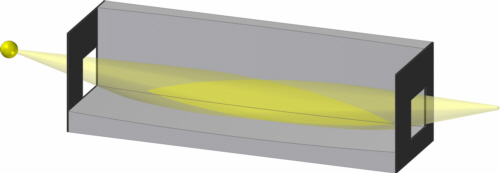
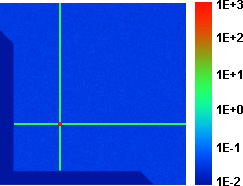
Fig. 2: Principle of Montel-optics (left) and simulated intensity distribution in the focal plane when no apertures are used (right): shadow of the mirrors (dark blue), direct rays (light blue), line foci (green) and focus point (red)
Kirkpatrick-Baez-optics [Kir 1948] consist of two mirrors. The surface of the first mirror is e.g. aligned horizontally, the second mirror is aligned vertically (fig. 3). In order to achive a common focal point, both mirrors have to be curved elliptically in a way, that leads go the horizontal focus line of the first mirror and the vertical focus line of the second mirror coinciding in the same plane. The curvature of the mirrors is realized by sophisticated and highly precise mechanics, allowing for focal spot diameters in the 50 nm range. The quality of the focal spot image of the X-ray source worsens rapidly, with the source point getting larger. The reason behind is that KB-optics do not fulfill the Abbé criterion, as the light is reflected only once per space direction. In Wolter optics this disadvantage is overcome. KB-mirrors are expensive (several 100 k€) and heavy (up to several tons).

Fig. 3: Principle of Kirkpatrick-Baez-optics
Rotational symmetric Wolter optics
Wolter optics are called after Hans Wolter, who 1952 described this type of optics [Wol 1952]. In the type I Wolter optics (see fig. 6) nowadays used for telescopes they consist of an elliptical or parabolic mirror followed by a hyperbolic mirror. The mirrors mostly are tubular, rotationally symmetric TER-mirrors. Wolter optics roughly fulfill the above mentioned Abbé criterion and therefore can be used as imaging optics. As the light is only reflected under grazing incidence, a single tubular mirror set does not catch much of the incoming light. Hence a set of nested mirrors is arranged concentrically to the optical axis (fig. 4). In this way the flux in the focal point is increased.
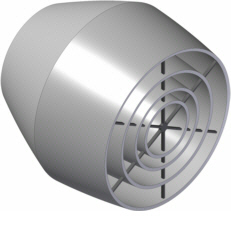
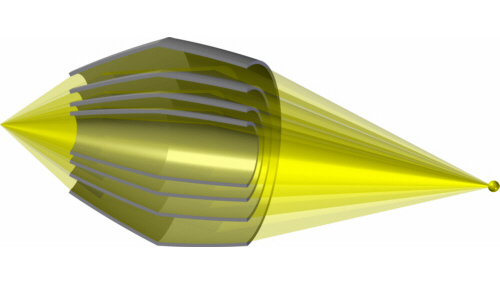
Fig. 4: Principle of Wolter optics: nested mirrors aligned with spider holder structures (left); half of a Wolter optics with rays from the source to the focus (right), on mouse over  the lost part of the incoming light is shown.
the lost part of the incoming light is shown.
Cylindrical Wolter optics
Wolter optics can be constructed by arranging elliptical (respectively parabolic) cylinders and hyperbolic cylinders (fig. 5). In this case the incoming light is focused in the horizontal direction by the first set of nested mirrors and thereafter vertically by the second set of nested mirrors.
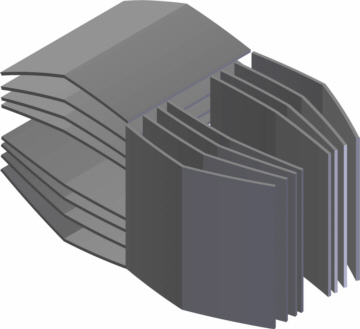

Fig. 5: Wolter optics with nested cylindrical mirrors (left); cylindrical mirror Wolter optics (upper front quarter removed to allow for a view into the optics) with rays from the source to the focus (right), on mouse over  the lost part of the incoming light is shown.
the lost part of the incoming light is shown.
Wolter optics theory
The optical path in Wolter optics is shown in fig. 6. Each ray coming from the source (yellow dot at the right side) to the focus (left side) is reflected at the elliptical surface first, then at the hyperbolic surface.
The effective optical aperture of these optics is limited by two effects. First, light hitting the edge of a mirror or the spider structures needed to position the mirrors is lost (shown on mouse over in fig. 4, 5 and 6). As the distance between two mirrors decreases towards the optical axis, the effective aperture of the inner shells decreases with an increasing thickness of the mirrors. That leads to the requirement of very thin mirrors (also necessary to reduce the weight of a satellite carrying the Wolter telescope!). Second, as the angle of the mirrors to the optical axis increases with increasing distance to the optical axis, the maximum aperture of the outermost mirror is limited by the the maximum angle of total internal reflection for the maximum photon energy of interest.
The efficiency of these optics depends on the ratio of effective aperture to total aperture, the reflectivity of the mirror surfaces and the amount of stray light produced by the surface roughness Ra of the mirrors (Ra has to be at least below 1 nm).

Fig. 6: Optical path in Wolter optics; lost rays of the incoming light are shown on mouse over 
H. Wolter has described three types of so called Wolter optics, named type I, type II and type III (fig. 7).
Type I Wolter optics (see fig. 7 top) consist of an elliptical mirror (or a parabolic mirror in the case the source is very distant, so the incoming light is parallel to the optical axis) followed by a hyperbolic mirror. The hyperbola has to be positioned in a way, that its mathematical focal point F1 (the one that is more distant from the light source!) coincides with the focal point of the ellipse (respectively parabola). If the light would only be reflected by the first mirror, it would be focussed in the point F1. After the reflection at the hyperbolic mirror it is focused in the point F2. So the focal length is reduced by the second mirror. This type of Wolter optics is used in X-ray telescopes, because of its relatively short focal length and the possibility to nest several mirrors in concentric shells to increase the total aperture.
Type II Wolter optics (see fig. 7 centre) again consist of an elliptical mirror (or once again a parabolic mirror in the case of a distant source, so the incoming light is parallel to the optical axis) followed by a hyperbolic mirror. But in this case the mathematical focal point F1 of the hyperbola being closer to the light source has to coincide with the focal point of the ellipse (respectively parabola). If the light would only be reflected by the first mirror, it would be focussed in the point F1. After the reflection at the hyperbolic mirror it is focused in the point F2. In this case the the focal length is increased by the second reflection. This type of optics can not be nested in shells.
Type III Wolter optics (see fig. 7 bottom) only work for incoming light nearly parallel to the optical axis, i.e. for very distant sources. They consist of a parabolic mirror followed by an elliptical mirror. In this case the mathematical focal point F1 of the parabola has to coincide with the focal point of the ellipse being closer to the light source. If the light would only be reflected by the first mirror, it would be defocussed with the virtual focal point in the point F1. After the reflection at the elliptical mirror it is focused in the point F2. In this case the the focal length is increased by the first reflection. This type of optics can not be nested in shells.
Wolter optics type I:
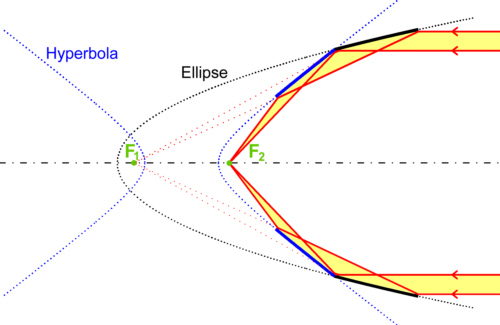
Wolter optics type II:
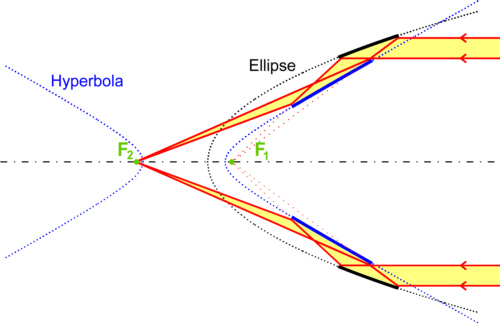
Wolter optics type III:
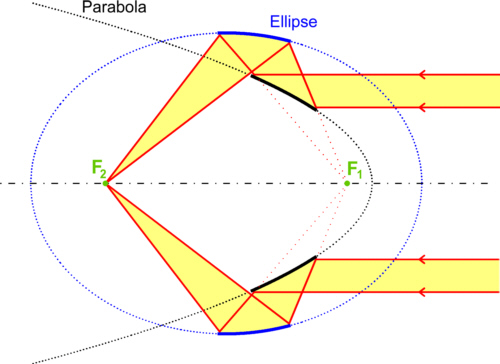
Fig. 7: Principle of the Wolter type I, II and III optics
Wolter optics are used in X-ray telescopes in astrophysics like the orbiting X-ray observatories Chandra and XMM-Newton, as well as in the Swift Gamma-Ray Burst Mission.
| [Kir 1948] | P. Kirkpatrick, A. V. Baez, Formation of optical images by X-rays, Journal Opt. Soc. Am., vol. 38, pp. 766-774, 1948 |
| [Mon 1957] | M. Montel, X-ray microscopy with catamegonic roof mirrors, X-ray microscopy and microradiography, Academic Press, New York, pp. 177-185, 1957 |
| [Sch 1905] | K. Schwarzschild, Untersuchungen zur geometrischen Optik, II. Astronomische Mitteilungen der Königlichen Sternwarte zu Göttingen, vol. 10, pp. 4-28, 1905 |
| [VDI 2009b] | VDI/VDE 5575 Blatt 4: 2009-xx Röntgenspiegel: Totalreflexions- und Multischichtspiegel (X-ray optical systems; mirror optics), Berlin, Beuth Verlag, (to be published) |
| [Wol 1952] | H. Wolter, Spiegelsysteme streifenden Einfalls als abbildende Optiken für Röntgenstrahlen, Annalen der Physik, vol. 10, pp. 94-114, DOI 10.1002/andp.19524450108, 1952 |


